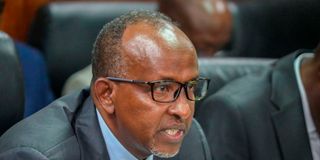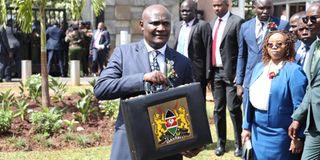Critical areas suffer cuts despite Sh138.1bn health budget boost

Health CS Aden Duale when he appeared before the National Assembly Health Committee at Parliament buildings Nairobi on May 15, 2025. He has requested the committee to rethink its budget, especially for the Semi-Autonomous Government Agencies.
What you need to know:
- In the financial year 2024/2025, Sh28.7 billion was allocated to programmes supported by the Global Fund, but this has been reduced to Sh17.3 billion in the new budget.
- This reduction of almost 40 percent comes at a time when donor support is already under threat. Earlier this year, US President Donald Trump issued Executive Order 14169, temporarily freezing USAID and other U.S. development assistance for 90 days. This freeze has since lapsed, leaving no clear pathway forward.
In a year marked by geopolitical tensions with donors and ongoing vaccine shortages, the government has increased its health budget to Sh138.1 billion for the financial year 2025/2026.
This represents 3.3 per cent of the total budget and marks an 8.7 per cent increase on the Sh127 billion allocated in the current fiscal year.
This budget increase signals the government’s commitment to Universal Health Coverage (UHC). However, it also highlights the fragile state of Kenya's healthcare financing, which remains heavily dependent on donor support.
"Access to quality and affordable healthcare through UHC is central to this government’s mission. To this end, I have proposed an allocation of Sh138.1 billion to the health sector to support various activities and programmes,” announced Mr John Mbadi, the Cabinet Secretary for National Treasury and Economic Planning, during the budget reading.

National Treasury Cabinet Secretary John Mbadi displays the Budget briefcase ahead of unveiling the government spending plan for 2025/26 in Parliament on June 12, 2025.
Despite the growth in the health budget, funding for some critical areas has stagnated or been cut. Notably, funding for the Global Fund, which supports the fight against HIV, tuberculosis, and malaria, has decreased substantially.
In the financial year 2024/2025, Sh28.7 billion was allocated to programmes supported by the Global Fund, but this has been reduced to Sh17.3 billion in the new budget.
This reduction of almost 40 percent comes at a time when donor support is already under threat. Earlier this year, US President Donald Trump issued Executive Order 14169, temporarily freezing USAID and other U.S. development assistance for 90 days. This freeze has since lapsed, leaving no clear pathway forward.
The executive order halted the disbursement of vital health supplies, including antiretrovirals and diagnostic kits, as well as funding for HIV care and support programmes. Consequently, the World Health Organization (WHO) has identified Kenya as one of eight countries at risk of HIV treatment shortages.
“Consistent with President Trump’s Executive Order on Reevaluating and Realigning United States Foreign Aid, Secretary Rubio has paused all U.S. foreign assistance funded by or through the State Department and U.S. Agency for International Development (USAID) for review. He is initiating a review of all foreign assistance programs to ensure they are efficient and consistent with US foreign policy under the America First agenda,” read the orders in part.
Vaccine shortage
Meanwhile, despite a national shortage of essential childhood vaccines, vaccine funding in Kenya has not changed. Both the 2024/2025 and 2025/2026 budgets have earmarked Sh4.6 billion for vaccine acquisition. This is particularly concerning given the ongoing shortfall in vaccine supply, estimated at Sh4.27.
The country has experienced shortages of key vaccines, including those for polio, measles and BCG, in several countries. On June 11, the Ministry of Health received a limited shipment of vaccine vials, which were dispatched to select county depots. However, this delivery was insufficient to replenish the national stock, leaving many clinics unable to provide routine immunisations.
UHC programme
The government has allocated Sh6.2 billion for the management and coordination of the UHC programme. This is slightly higher than the previous year's allocation of Sh4.2 billion, suggesting increased investment in administrative and policy coordination within the health sector. However, this increase has not addressed the ongoing strike by doctors contracted under the UHC programme.
These healthcare workers, who were employed on short-term contracts to facilitate the UHC rollout in counties, have stopped working, demanding permanent employment, better pay, and inclusion in the national medical scheme. Their needs were not explicitly considered in the budget, leaving their future uncertain.
Despite these challenges, certain areas of the budget have seen increases. For example, the Primary Healthcare Fund has grown from Sh7.1 billion to Sh13 billion, indicating a commitment to strengthening grassroots health services.
ECCIF funding
Additionally, the Emergency, Chronic, and Critical Illness Fund (ECCIF) has risen from Sh5 billion to Sh8 billion, demonstrating the government’s growing awareness of the need for long-term, sustainable healthcare infrastructure. New allocations have also been introduced for health system resilience and emergency preparedness, totalling Sh1.1 billion.
New allocations have also been introduced for health system resilience and emergency preparedness, with Sh1.1 billion allocated to each. This is a positive step towards improving Kenya’s ability to respond to future health emergencies and strengthening its institutions.
Further analysis of other budget lines reveals significant reallocations. Referral hospitals, including Kenyatta National Hospital, Moi Teaching and Referral Hospital, and Kenyatta University Teaching, Referral and Research Hospital, have received a combined total of Sh42.4 billion.
The Burns and Paediatrics Centre at Kenyatta National Hospital has been allocated Sh1.3 billion, which is a notable decrease from Sh2.6 billion in the previous year. While the budget documents do not explain this reduction, it may indicate that major phases of the project were completed last year, resulting in decreased funding needs.
Cancer centres
Meanwhile, funding for the construction and strengthening of cancer centres has increased slightly, rising from Sh1.1 billion to Sh1.2 billion, as the government acknowledges the growing burden that cancer poses to the healthcare system. Kenya reports over 42,000 new cancer cases each year, with cancer now ranking as the third leading cause of death in the country. These funds are intended to support the expansion and equipping of cancer centres, including those at Kisii Teaching and Referral Hospital, Kenyatta National Hospital and Kenyatta University Teaching, Referral and Research Hospital, to alleviate the pressure on existing facilities.
Additionally, funding for managing medical personnel has remained consistent at Sh4.1 billion, reflecting a stable approach to staffing and human resource development in healthcare. Sh430 million has also been allocated for medical coverage for the elderly, orphans and people with disabilities.
The Kenya Medical Supplies Authority (KEMSA) has been allocated Sh52 billion, while the Kenya Medical Research Institute (KEMRI) will receive Sh2.7 billion. The Kenya Medical Training Colleges (KMTCs) have been allocated Sh8.9 billion, of which Sh300 million is earmarked for the training of healthcare professionals. Medical interns have been allocated Sh4.3 billion and community health promoters (CHPs) Sh3.2 billion.


